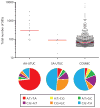Mutational signature of aristolochic acid exposure as revealed by whole-exome sequencing
- PMID: 23926200
- PMCID: PMC3973132
- DOI: 10.1126/scitranslmed.3006200
Mutational signature of aristolochic acid exposure as revealed by whole-exome sequencing
Abstract
In humans, exposure to aristolochic acid (AA) is associated with urothelial carcinoma of the upper urinary tract (UTUC). Exome sequencing of UTUCs from 19 individuals with documented exposure to AA revealed a remarkably large number of somatic mutations and an unusual mutational signature attributable to AA. Most of the mutations (72%) in these tumors were A:T-to-T:A transversions, located predominantly on the nontranscribed strand, with a strong preference for deoxyadenosine in a consensus sequence (T/CAG). This trinucleotide motif overlaps the canonical splice acceptor site, possibly accounting for the excess of splice site mutations observed in these tumors. The AA mutational fingerprint was found frequently in oncogenes and tumor suppressor genes in AA-associated UTUC. The AA mutational signature was observed in one patient's tumor from a UTUC cohort without previous indication of AA exposure. Together, these results directly link an established environmental mutagen to cancer through genome-wide sequencing and highlight its power to reveal individual exposure to carcinogens.
Conflict of interest statement
Figures



Comment in
-
Genomics traces carcinogen fingerprints.Sci Transl Med. 2013 Aug 7;5(197):197fs31. doi: 10.1126/scitranslmed.3006810. Sci Transl Med. 2013. PMID: 23926198
-
Bladder cancer: aristolochic acid--one of the most potent carcinogens known to man.Nat Rev Urol. 2013 Oct;10(10):552. doi: 10.1038/nrurol.2013.186. Epub 2013 Aug 27. Nat Rev Urol. 2013. PMID: 23979661 No abstract available.
References
-
- Kumar V, Poonam, Prasad AK, Parmar VS. Naturally occurring aristolactams, aristolochic acids and dioxoaporphines and their biological activities. Nat Prod Rep. 2003;20:565–583. - PubMed
-
- Grollman AP, Scarborough J, Jelakovic B. In: Advances in Molecular Toxicology. Fishbein J, editor. Vol. 3. Elsevier; Amsterdam: 2009. pp. 211–222.
-
- Vanherweghem JL, Tielemans C, Abramowicz D, Depierreux M, Vanhaelen-Fastre R, Vanhaelen M, Dratwa M, Richard C, Vandervelde D, Verbeelen D, Jadoul M. Rapidly progressive interstitial renal fibrosis in young women: Association with slimming regimen including Chinese herbs. Lancet. 1993;341:387–391. - PubMed
-
- Vanherweghem JL, Debelle F, Muniz-Martinez M-C, Nortier J. In: Clinical Nephrotoxins. de Broe ME, Porter GA, Bennet WM, Verpooten GA, editors. Kluwer; Dordrecht: 2003. pp. 588–601.
-
- Cosyns JP, Jadoul M, Squifflet JP, Wese FX, van Ypersele de Strihou C. Urothelial lesions in Chinese-herb nephropathy. Am J Kidney Dis. 1999;33:1011–1017. - PubMed
Publication types
MeSH terms
Substances
Grants and funding
LinkOut - more resources
Full Text Sources
Other Literature Sources

